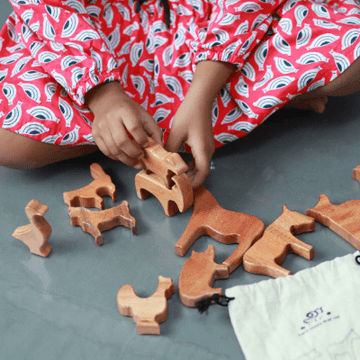(Author Ms.Nithya Ramachandran - Montessori Guide and Consultant)

“Playing and growing are synonymous with life itself. Playfulness bespeaks creativity and action, change and possibility of transformation”
Elizabeth Wood
At the onset, ‘play’ sounds like a word that we all know well and therefore should be able to easily define. After all, play has been happening well before our time and is likely to continue well after us. Our parents played, we played, our children play and so will the generations to come.
However, defining play isn’t as easy. Play can be defined from various contexts and perspectives depending on who is playing, what are they playing with and how are they playing with it. But irrespective of how play is defined, there is a consensus in early childhood literature, that play of all kinds is beneficial to children.
- Play can be both structured and open.
- Structured play is when the adult or the material itself usually defines the rules for the child about how to play. For example, board games, team sports and puzzles.
- Open ended play is when the children decide how to use something and play with it. This form of play has fewer or no rules and is more flexible than structured play.
- Many toys can be used both for structured and open play depending on how they are played with and there are benefits to both kinds of play.

Let’s explore the benefits of open-ended play.
- Creativity
Open-ended play has no rules, and this opens lots of possibilities for your child to play the way want. They come up with different ways to use the same toy and various ways to play with it. This leads to them getting creative with their toys and their ideas on how to use them as well.
- Spontaneity
Open ended play leads children to get lost in worlds of their own where they often need to come up a plan on the spot as well as work on the execution of that play which builds their skill and ability to be spontaneous.
- Flexibility
Children are free to use materials the way they wish in open-ended play. This makes them think outside the box and be flexible about their ideas, how to use the materials they have as well as how to play with them.
 Imagination
Imagination
When they are playing, children become creators of their own world, stories, and characters in it. Play situations kindle the imagination and open their minds to unlimited possibilities.
- Problem Solving
When children play, they may come up with problems and work at a solution by themselves or together. Experimentation, taking risks, trials and errors and testing out a hypothesis are all organically interwoven into play.
- Social skills
When two or more children play together, they automatically use and hone their social skills. They learn to look at things from others’ perspective and to empathise. They work together and learn to value differences as well. They learn to take different ideas into consideration and come up with a plan that everyone is on board with.

- Fine and gross motor skills
Play of all kinds, require a lot of movement. Whether it be constructing things, moving things, stacking things putting things together or taking them apart, they all involve both large muscle groups and finer motor skills. Play is also a constructive outlet for all the pent-up energy that young children often have.
- Language skills
Play involves communication between those participating in it (whether the players be real or imaginary). This organic need for communicating about play and in play, offers children opportunities to use symbols, gestures as well as both simple and complex language. Have you noticed how even children who don’t have any language in common, can play with each other successfully? This means that they develop their own language of communicating with each other.






